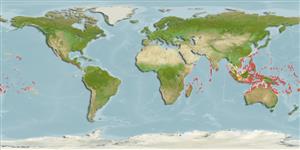Actinopterygii (ray-finned fishes) >
Beryciformes (Sawbellies) >
Holocentridae (Squirrelfishes, soldierfishes) > Holocentrinae
Etymology: Neoniphon: Greek, neos = new + Greek, niphon = to snow (Ref. 45335).
Environment / Climate / Range
Ecology
Marine; reef-associated; depth range 3 - 25 m (Ref. 90102). Tropical, preferred ?; 30°N - 24°S
Indo-Pacific: East Africa to the Tuamoto Islands, north to the Ryukyu Islands, south to New Caledonia.
Size / Weight / Age
Maturity: Lm ? range ? - ? cm
Max length : 35.0 cm TL male/unsexed; (Ref. 5213); common length : 23.0 cm TL male/unsexed; (Ref. 9948)
Dorsal
spines
(total): 11;
Dorsal
soft rays
(total): 12-14;
Anal
spines: 4;
Anal
soft rays: 8 - 9. Body iridescent silvery with dark red or black mark on each scale (Ref. 4201). Spinous portion of dorsal fin black; soft dorsal, anal and caudal fins reddish yellow; pectoral fins pink, pelvic fins white (Ref. 4201). Lower jaw strongly projecting
Inhabits subtidal reef flats and lagoon and seaward reefs to depths of at least 20 m. Found singly or in small groups in coral-rich areas (Ref. 9710). Feeds mainly on benthic crabs and shrimps. Large spine at the corner of preopercle is venomous. It raises or flashes its distinctly marked dorsal fin to startle possible predator (Ref. 48635).
Life cycle and mating behavior
Maturity | Reproduction | Spawning | Eggs | Fecundity | Larvae
Myers, R.F., 1991. Micronesian reef fishes. Second Ed. Coral Graphics, Barrigada, Guam. 298 p. (Ref. 1602)
IUCN Red List Status (Ref. 115185)
CITES (Ref. 94142)
Not Evaluated
Human uses
Fisheries: minor commercial
More information
Common namesSynonymsMetabolismPredatorsEcotoxicologyReproductionMaturitySpawningFecundityEggsEgg development
ReferencesAquacultureAquaculture profileStrainsGeneticsAllele frequenciesHeritabilityDiseasesProcessingMass conversion
Tools
Special reports
Download XML
Internet sources
Estimates of some properties based on models
Phylogenetic diversity index (Ref.
82805): PD
50 = 0.5312 [Uniqueness, from 0.5 = low to 2.0 = high].
Trophic Level (Ref.
69278): 3.6 ±0.59 se; Based on food items.
Resilience (Ref.
69278): High, minimum population doubling time less than 15 months (Preliminary K or Fecundity.).
Vulnerability (Ref.
59153): Low to moderate vulnerability (25 of 100) .
